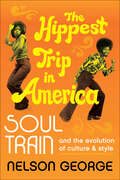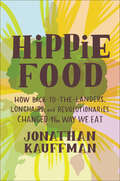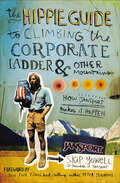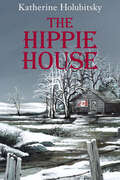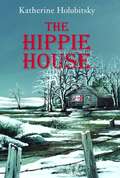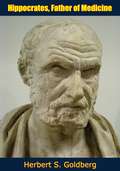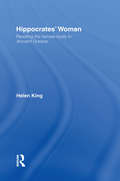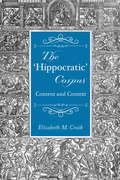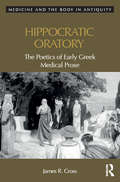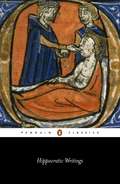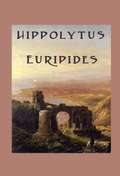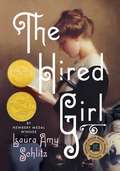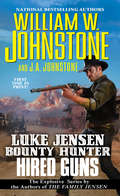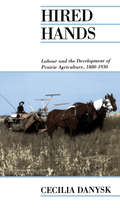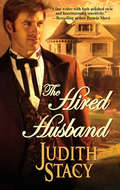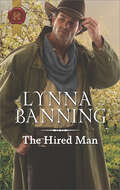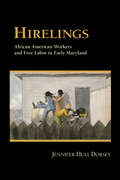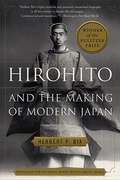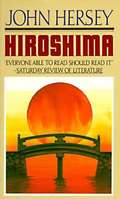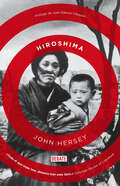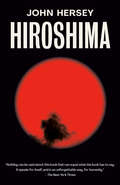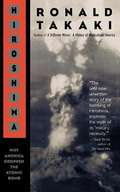- Table View
- List View
The Hippest Trip in America: Soul Train and the Evolution of Culture & Style
by Nelson GeorgeAn authoritative history of the groundbreaking syndicated television show that has become an icon of American pop culture, from acclaimed author and filmmaker Nelson George, “the most accomplished black music critic of his generation” (Washington Post Book World).When it debuted in October 1971, seven years after the Civil Rights Act, Soul Train boldly went where no variety show had gone before, showcasing the cultural preferences of young African-Americans and the sounds that defined their lives: R&B, funk, jazz, disco, and gospel music. The brainchild of radio announcer Don Cornelius, the show’s producer and host, Soul Train featured a diverse range of stars, from James Brown and David Bowie to Christine Aguilera and R. Kelly; Marvin Gaye and Elton John to the New Kids on the Block and Stevie Wonder.The Hippest Trip in America tells the full story of this pop culture phenomenon that appealed not only to blacks, but to a wide crossover audience as well. Famous dancers like Rosie Perez and Jody Watley, performers such as Aretha Franklin, Al Green, and Barry White, and Cornelius himself share their memories, offering insights into the show and its time—a period of extraordinary social and political change. Colorful and pulsating, The Hippest Trip In America is a fascinating portrait of a revered cultural institution that has left an indelible mark on our national consciousness.
Hippie Food: How Back-to-the-Landers, Longhairs, and Revolutionaries Changed the Way We Eat
by Jonathan KauffmanAn enlightening narrative history—an entertaining fusion of Tom Wolfe and Michael Pollan—that traces the colorful origins of once unconventional foods and the diverse fringe movements, charismatic gurus, and counterculture elements that brought them to the mainstream and created a distinctly American cuisine.Food writer Jonathan Kauffman journeys back more than half a century—to the 1960s and 1970s—to tell the story of how a coterie of unusual men and women embraced an alternative lifestyle that would ultimately change how modern Americans eat. Impeccably researched, Hippie Food chronicles how the longhairs, revolutionaries, and back-to-the-landers rejected the square establishment of President Richard Nixon’s America and turned to a more idealistic and wholesome communal way of life and food.From the mystical rock-and-roll cult known as the Source Family and its legendary vegetarian restaurant in Hollywood to the Diggers’ brown bread in the Summer of Love to the rise of the co-op and the origins of the organic food craze, Kauffman reveals how today’s quotidian whole-foods staples—including sprouts, tofu, yogurt, brown rice, and whole-grain bread—were introduced and eventually became part of our diets. From coast to coast, through Oregon, Texas, Tennessee, Minnesota, Michigan, Massachusetts, and Vermont, Kauffman tracks hippie food’s journey from niche oddity to a cuisine that hit every corner of this country.A slick mix of gonzo playfulness, evocative detail, skillful pacing, and elegant writing, Hippie Food is a lively, engaging, and informative read that deepens our understanding of our culture and our lives today.
The Hippie Guide to Climbing the Corporate Ladder & Other Mountains: How JanSport Makes It Happen
by Skip YowellThe Hippie Guide to Climbing the Corporate Ladder & Other Mountains chronicles the dramatic adventures and accomplishments of the man behind one of the world's most recognized brands. From small-town Kansas boy to adventure-junkie extraordinaire, this book traces Skip Yowell's journey to the top of the outdoor industry. Full of insightful details and photos from around the world, this books offer a behind-the-scenes look at how Skip and his team built a successful company--and changed an entire industry--by breaking the rules and taking good care of their customers. "Skip's account of the founding of JanSport wreaks of honesty, humor, and enough anecdotes to stir a memory in almost anyone who has spent time outside. His tale takes you from a small room above a transmission shop to a global enterprise and packs enough adventures to keep the fire stoked and the beer on ice for hours." -Larry Burke, Editor-in-Chief, Outside Magazine "This amazing book chronicles the life of Skip Yowell, a man who climbed the corporate ladder not in a suit and tie, but in hiking boots and with a backpack. He did so in style, and had tons of fun doing it. He stayed true to himself, maintained friendships, traveled the world and most importantly, preserved his passion for his job.... We can all learn something from Skip, who started building backpacks from scratch and created a company that is now a giant in the industry. His honesty and passion for life are his priority, which all of his friends and business associates can attest to. The world would be a better place with more people like Skip Yowell. I am proud to have him as my friend and encourage you to get to know his story! You will be inspired." -Ed Viesturs, First American to climb all fourteen 8,000 meter peaks, Author of No Shortcuts to the Top "I wish this enlightening book had been available 30 years ago. The inspiration I have derived from it now would have been welcomed then. Like a new band without a 'label' (either style or record company), with originality and dedication it shows how JanSport forged their own way and set the high marks for others to strive for. This 'how it was done' book should be read by all aspiring musicians, for the principles of success are universal and are defined within." -John McEuen, Founding Member of the Nitty Gritty Dirt Band
The Hippie House
by Katherine HolubitskyThe "summer of love" is a time of idealistic freedom and experimentation for Emma, her cousin Megan, and the young people of Pike Creek. While her brother Eric's band practices in what Uncle Pat has dubbed the Hippie House, the girls suntan on their small lake and hitchhike into town to hang around the Drop-In Center. They find the growing crowd of long-haired musicians and hangers-on that begin to show up at the farm both enticing and a bit scary. The beginning of the school year brings excitement and change for Emma. But when eighteen-year-old Katie Russell disappears, her teenage sense of immortality is suddenly shattered. A month later, when Eric discovers Katie's body in the Hippie House, the entire community is thrown into turmoil. There are plenty of suspects in the brutal murder, but for months the case remains unsolved. And while others speculate, Eric agonizes that the killer may have been one of the many drifters who passed through the Hippie House during the summer.
Hippie House
by Katherine HolubitskySummer, 1970. When a local girl is found brutally murdered, the freedom and innocence of "the summer of love" are forgotten and for fourteen-year-old Emma, things will never be the same.
Hippocrates, Father of Medicine: Father Of Medicine
by Herbert S. GoldbergFirst published in 1963, this book by University of Missouri Microbiology Professor Herbert S. Goldberg provides the reader with a picture of the life and times of Hippocrates, the “Father of Medicine.” Hippocrates was born on the island of Cos in 460 B.C., and his works remained for centuries the foundation of medical and biographical knowledge. In addition, it was Hippocrates daring approach to the problems of sickness and disease that drove the opening wedge into the wall of fear that surrounded human ills. Hippocrates scrupulous attention to professional ethics is honored even to this day by the medical oath that bears his name—The Hippocratic Oath.Goldberg accurately describes the professions and trades during Hippocrates time, as well as the early education of youth in ancient Greece. Medicines were not based on science, but on driving evil spirits from the body. Hippocrates scientific approach to the study and treatment of disease has deservedly earned for him the title of “Father of Medicine.”
Hippocrates' Woman: Reading the Female Body in Ancient Greece
by Helen KingHippocrates' Woman demonstrates the role of Hippocratic ideas about the female body in the subsequent history of western gynaecology. It examines these ideas not only in the social and cultural context in which they were first produced, but also the ways in which writers up to the Victorian period have appealed to the material in support of their own theories.Among the conflicting tange of images of women given in the Hippocratic corpus existed one tradition of the female body which says it is radically unlike the male body, behaving in different ways and requiring a different set of therapies. This book sets this model within the context of Greek mythology, especially the myth of Pandora and her difference from men, to explore the image of the body as something to be read.Hippocrates' Woman presents an arresting study of the origins of gynaecology, an exploration of how the interior workings of the female body were understood and the influence of Hippocrates' theories on the gynaecology of subsequent ages.
The 'Hippocratic' Corpus: Content and Context
by Elizabeth M. CraikThe Hippocratic Corpus comprises some sixty medical works of varying length, style and content. Collectively, this is the largest surviving body of early Greek prose. As such, it is an invaluable resource for scholars and students not only of ancient medicine but also of Greek life in general. Hippocrates lived in the age of Socrates and most of the treatises seem to originate in the classical period. There is, however, no consensus on Hippocratic attribution. The ‘Hippocratic’ Corpus examines the works individually under the broad headings: content - each work is summarised for the reader comment - the substance and style of each work is discussed context is provided not just in relation to the corpus as a whole but also to the work’s wider relevance. Whereas the scholar or student approaching, say, Euripides or Herodotus has a wealth of books available to provide introduction and orientation, no such study has existed for the Hippocratic Corpus. As The ‘Hippocratic’ Corpus has a substantial introduction, and as each work is summarised for the reader, it facilitates use and exploration of an important body of evidence by all interested in Greek medicine and society. Elizabeth Craik is Honorary Professor at University of St Andrews and Visiting Professor at University of Newcastle, UK.
Hippocratic Oratory: The Poetics of Early Greek Medical Prose (Medicine and the Body in Antiquity)
by James R. CrossOn Ancient Medicine, On the Art, On Breaths, On the Nature of Human Beings and On the Sacred Disease are among the most well-known and sophisticated works of the Hippocratic Collection. The authors of these treatises were seeking to find means to express their arguments that built on authoritative models of their predecessors. By examining the range of expressive resources used in their expository prose, James Cross demonstrates how oral tradition and written techniques, such as sound patterning, sign-posting and antithetical formulae, were deployed to help the writers develop a case. The book demonstrates that there were various layers of meaning and manners of communicating ideas which can be found in Hippocratic expository prose, and offers fresh insights into the oral debating culture and experiments in persuasion which characterise the ancient Greek world of the late fifth-century BCE.
Hippocratic Writings
by HippocratesThis work is a sampling of the Hippocratic Corpus, a collection of ancient Greek medical works. At the beginning, and interspersed throughout, there are discussions on the philosophy of being a physician. There is a large section about how to treat limb fractures, and the section called The Nature of Man describes the physiological theories of the time. The book ends with a discussion of embryology and a brief anatomical description of the heart.
Hippolytus
by EuripidesNo play of Euripides is more admired than Hippolytus. The tale of a married woman stirred to passion for a younger man was traditional, but Euripides modified this story and blended it with one of divine vengeance to create a masterpiece of tension, pathos, and dramatic power. In this play, Phaedra fights nobly but unsuccessfully against her desire for her stepson Hippolytus, while the young man risks his life to keep her passion secret. Both of them, constrained by the overwhelming force of divine power and human ignorance, choose to die in order to maintain their virtue and their good names.
Hira Singh
by Talbot MundyOne hundred Indian troops of the British Army have arrived at Kabul, Afghanistan, after a four months' march from Constantinople. The men were captured in Flanders by the Germans and were sent to Turkey in the hope that, being Mohammedans, they might join the Turks. But they remained loyal to Great Britain and finally escaped, heading for Afghanistan. They now intend to join their regimental depot in India, so it is reported. New York Times, July, 1915
The Hired Girl
by Laura Amy SchlitzFourteen-year-old Joan Skraggs, just like the heroines in her beloved novels, yearns for real life and true love. But what hope is there for adventure, beauty, or art on a hardscrabble farm in Pennsylvania where the work never ends? <P><P> Over the summer of 1911, Joan pours her heart out into her diary as she seeks a new, better life for herself--because maybe, just maybe, a hired girl cleaning and cooking for six dollars a week can become what a farm girl could only dream of--a woman with a future. <P><P>Newbery Medalist Laura Amy Schlitz relates Joan's journey from the muck of the chicken coop to the comforts of a society household in Baltimore (Electricity! Carpet sweepers! Sending out the laundry!), taking readers on an exploration of feminism and housework; religion and literature; love and loyalty; cats, hats, and bunions.
Hired Guns (Luke Jensen Bounty Hunter #8)
by William W. Johnstone J.A. JohnstoneJohnstone Country. Where Frontier Legends Are Born. A legend among bounty hunters, Luke Jensen has tracked some of the deadliest outlaws in the West. But sometimes, the competition can be even deadlier . . . GHOST TOWN MASSACRE It’s the kind of job Luke Jensen hates. A millionaire mine owner is willing to pay $5,000 to the man who captures the half-breed outlaw Tom Eagle. Normally, Luke would turn down an offer like this—it smacks too much of being a hired gun. But when the millionaire tells him that Eagle is responsible for killing his son, Luke agrees to take on the job. Which means he’ll have to take the road to hell itself—aka Hard Rock, Montana . . . Hard Rock is supposed to be a ghost town. But when Luke arrives, the ghosts are alive and well—and gunning for his hide. They’re a gang of actual hired guns—the kind of soulless killers Luke despises—and they’re trying to collect the bounty, too. Luke barely makes it out of town alive when he runs in to the only man who can save him. The man he’s been hired to hunt. The notorious Tom Eagle . . . Live Free. Read Hard.
Hired Hands:
by Cecilia DanyskFarm workers were central to the development of Canada's prairie West. From 1878, when the first shipment of prairie grain went to international markets, to 1929, when the Great Depression signalled the end of the wheat boom, the role of hired hands changed dramatically. Prior to World War One, hired hands viewed themselves and were treated in the rural community as equals to their farmer employers. Many were farmers in training, informal apprentices who worked for wages so they could accumulate the capital and experience needed to secure their own free 160-acre parcels of land. In later years, as free lands were taken, hired hands increasingly faced the hkehhood of remaining waged labourers on the farms of others. They became agricultural proletarians. In this first full-length study of labour in Canadian prairie agriculture during the period of settlement and expansion, Cecilia Danysk examines the changing work and the growing rural community of the West through the eyes of the workers themselves. World War One was a catalyst in bringing into focus the conflicting nature of labour-capital relations and the divergent aims of workers and their employers. Yet, attempts at union organization were unsuccessful because most hired hands worked alone and because governments assisted farmers by stifling such attempts. The workers' greatest form of workplace control was to walk off one job and find another. Previously published by McClelland & Stewart
The Hired Husband
by Judith StacyHIRED HELP?With her father's business empire crumbling around her, Miss Rachel Branford will try anything to save her family's name. Even if it means offering handsome financial consultant Mitch Kincade a room in her house-and four times his usual fee!OR HIRED HUSBAND?Abandoned at an orphanage, Mitch has struggled to gain wealth and power. But all that changes when he finds himself tempted by Rachel's money...then Rachel herself. Especially when drawn into a contract of marriage...
The Hired Man: The Wallflower's Mistletoe Wedding Her Christmas Knight The Hired Man (Harlequin Historical Ser. #Vol. 480)
by Lynna BanningA home for the drifter Cordell Winterman is haunted by his mistakes-and the years spent paying for them. Broke and hungry, he takes a job as a hired man on Eleanor Malloy's farm. Eleanor needs help. Desperately. Her kids are running wild and the place is held up by spit and rust. But as Cord helps her set her home to rights, Eleanor realizes she doesn't just need this enigmatic drifter with hunger in his eyes...she wants him, too!
Hirelings: African American Workers and Free Labor in Early Maryland
by Jennifer Hull DorseyIn Hirelings, Jennifer Hull Dorsey re-creates the social and economic milieu of Maryland’s Eastern Shore at a time when black slavery and black freedom existed side by side. She follows a generation of manumitted African Americans and their freeborn children and grandchildren through the process of inventing new identities, associations, and communities in the early nineteenth century. Free Africans and their descendants had lived in Maryland since the seventeenth century, but before the American Revolution they were always few in number and lacking in economic resources or political leverage. By contrast, manumitted and freeborn African Americans in the early republic refashioned the Eastern Shore’s economy and society, earning their livings as wage laborers while establishing thriving African American communities. As free workers in a slave society, these African Americans contested the legitimacy of the slave system even while they remained dependent laborers. They limited white planters’ authority over their time and labor by reuniting their families in autonomous households, settling into free black neighborhoods, negotiating labor contracts that suited the needs of their households, and worshipping in the African Methodist Episcopal Church. Some moved to the cities, but many others migrated between employers as a strategy for meeting their needs and thwarting employers’ control. They demonstrated that independent and free African American communities could thrive on their own terms. In all of these actions the free black workers of the Eastern Shore played a pivotal role in ongoing debates about the merits of a free labor system.
Hiring Fair (The Stalker Trilogy #2)
by Jessica StirlingThis is the second book in the trilogy recounting the story of the Stalker's. Drew studies law in Edinburgh determined never to return to the poverty of his childhood. Mirrin, after her bitter experiences with Houston Lamont, owner of Blacklaw Colliery, soon has to decide whether to try her luck on the London music-hall stage or search for the man who could bring her happiness. Life was changing too for the Stalkers who remained in Blacklaw. After a bloody pit riot Houston Lamont joins his avaricious wife in an unholy alliance to drain every drop of profit out of the miners. Look for the other books in the Stalker trilogy, a sweeping historical family saga about life in Scotland in the 1870s in the Bookshare collection. They are: #1 The Spoiled Earth and #2 The Dark Pasture. These novels are authentic in detail and lavishly describe the rural and city landscapes and lives of the Scottish people in the lower, middle and wealthy classes as they seek sustenance, security, advancement, and fulfillment. You will find another trilogy by Jessica Stirling, The Isle of Mull Trilogy which are: #2 The Wind From the Hills and #3
Hirohito And The Making Of Modern Japan
by Herbert P. BixWinner of the Pulitzer PrizeIn this groundbreaking biography of the Japanese emperor Hirohito, Herbert P. Bix offers the first complete, unvarnished look at the enigmatic leader whose sixty-three-year reign ushered Japan into the modern world. Never before has the full life of this controversial figure been revealed with such clarity and vividness. Bix shows what it was like to be trained from birth for a lone position at the apex of the nation's political hierarchy and as a revered symbol of divine status. Influenced by an unusual combination of the Japanese imperial tradition and a modern scientific worldview, the young emperor gradually evolves into his preeminent role, aligning himself with the growing ultranationalist movement, perpetuating a cult of religious emperor worship, resisting attempts to curb his power, and all the while burnishing his image as a reluctant, passive monarch. Here we see Hirohito as he truly was: a man of strong will and real authority.Supported by a vast array of previously untapped primary documents, Hirohito and the Making of Modern Japan is perhaps most illuminating in lifting the veil on the mythology surrounding the emperor's impact on the world stage. Focusing closely on Hirohito's interactions with his advisers and successive Japanese governments, Bix sheds new light on the causes of the China War in 1937 and the start of the Asia-Pacific War in 1941. And while conventional wisdom has had it that the nation's increasing foreign aggression was driven and maintained not by the emperor but by an elite group of Japanese militarists, the reality, as witnessed here, is quite different. Bix documents in detail the strong, decisive role Hirohito played in wartime operations, from the takeover of Manchuria in 1931 through the attack on Pearl Harbor and ultimately the fateful decision in 1945 to accede to an unconditional surrender. In fact, the emperor stubbornly prolonged the war effort and then used the horrifying bombings of Hiroshima and Nagasaki, together with the Soviet entrance into the war, as his exit strategy from a no-win situation. From the moment of capitulation, we see how American and Japanese leaders moved to justify the retention of Hirohito as emperor by whitewashing his wartime role and reshaping the historical consciousness of the Japanese people. The key to this strategy was Hirohito's alliance with General MacArthur, who helped him maintain his stature and shed his militaristic image, while MacArthur used the emperor as a figurehead to assist him in converting Japan into a peaceful nation. Their partnership ensured that the emperor's image would loom large over the postwar years and later decades, as Japan began to make its way in the modern age and struggled -- as it still does -- to come to terms with its past.Until the very end of a career that embodied the conflicting aims of Japan's development as a nation, Hirohito remained preoccupied with politics and with his place in history. Hirohito and the Making of Modern Japan provides the definitive account of his rich life and legacy. Meticulously researched and utterly engaging, this book is proof that the history of twentieth-century Japan cannot be understood apart from the life of its most remarkable and enduring leader.
Hirohito and the Making of Modern Japan
by Herbert P. BixWinner of the Pulitzer Prize. In this groundbreaking biography of the Japanese emperor Hirohito, Herbert P. Bix offers the first complete, unvarnished look at the enigmatic leader whose sixty-three-year reign ushered Japan into the modern world. Never before has the full life of this controversial figure been revealed with such clarity and vividness. Bix shows what it was like to be trained from birth for a lone position at the apex of the nation's political hierarchy and as a revered symbol of divine status. Influenced by an unusual combination of the Japanese imperial tradition and a modern scientific worldview, the young emperor gradually evolves into his preeminent role, aligning himself with the growing ultranationalist movement, perpetuating a cult of religious emperor worship, resisting attempts to curb his power, and all the while burnishing his image as a reluctant, passive monarch. Here we see Hirohito as he truly was: a man of strong will and real authority.Supported by a vast array of previously untapped primary documents, Hirohito and the Making of Modern Japan is perhaps most illuminating in lifting the veil on the mythology surrounding the emperor's impact on the world stage. Focusing closely on Hirohito's interactions with his advisers and successive Japanese governments, Bix sheds new light on the causes of the China War in 1937 and the start of the Asia-Pacific War in 1941. And while conventional wisdom has had it that the nation's increasing foreign aggression was driven and maintained not by the emperor but by an elite group of Japanese militarists, the reality, as witnessed here, is quite different. Bix documents in detail the strong, decisive role Hirohito played in wartime operations, from the takeover of Manchuria in 1931 through the attack on Pearl Harbor and ultimately the fateful decision in 1945 to accede to an unconditional surrender. In fact, the emperor stubbornly prolonged the war effort and then used the horrifying bombings of Hiroshima and Nagasaki, together with the Soviet entrance into the war, as his exit strategy from a no-win situation. From the moment of capitulation, we see how American and Japanese leaders moved to justify the retention of Hirohito as emperor by whitewashing his wartime role and reshaping the historical consciousness of the Japanese people. The key to this strategy was Hirohito's alliance with General MacArthur, who helped him maintain his stature and shed his militaristic image, while MacArthur used the emperor as a figurehead to assist him in converting Japan into a peaceful nation. Their partnership ensured that the emperor's image would loom large over the postwar years and later decades, as Japan began to make its way in the modern age and struggled -- as it still does -- to come to terms with its past.Until the very end of a career that embodied the conflicting aims of Japan's development as a nation, Hirohito remained preoccupied with politics and with his place in history. Hirohito and the Making of Modern Japan provides the definitive account of his rich life and legacy. Meticulously researched and utterly engaging, this book is proof that the history of twentieth-century Japan cannot be understood apart from the life of its most remarkable and enduring leader.
Hiroshima
by John HerseyMemories and tales from the survivors of the atomic bomb dropped on Hiroshima on August 6, 1945. 37 years later, Hersey went back to Japan. The final chapter is what he found there.
Hiroshima
by John HerseyLa crónica sobre seis supervivientes de Hiroshima que se convirtió en un gran clásico del periodismo. «Toda persona que sepa leer, debería leer este libro.»Saturday Review of Literature El verano de 1945, William Shawn, director ejecutivo de The New Yorker, habló con el reportero John Hersey sobre la idea de publicar un relato que ilustrara la dimensión humana de los efectos de la bomba atómica en Hiroshima, pues le causaba estupor comprobar que, pese a la gran cantidad de información sobre la bomba que recibían, se estaba ignorando lo que realmente había ocurrido en Hiroshima. El reportero aceptó el encargo. Hershey viajó a Hiroshima para investigar y entrevistar a varios supervivientes de la explosión de la bomba atómica, lanzada el 6 de agosto de 1945, y decidió que el retrato lo conformarían seis testimonios: una oficinista, Toshiko Sasaki; un médico, el Dr. Masakazu Fuji;una viuda a cargo de sus tres hijos pequeños, Hatsuyo Nakamura; un misionero alemán, el padre Wilhem Kleinsorge; un joven cirujano, el Dr. Terufumi Sasaki y un pastor metodista, el reverendo Kiyoshi Tanimoto. La publicación de Hiroshima trajo consigo una enorme conmoción. El reportaje se publicó en una edición monotemática de The New Yorker el 31 de agosto de 1946. La revista se agotó inmediatamente y de todo el mundo llegó una avalancha de peticiones de reimpresión. Su difusión corrió como la pólvora y en pocos meses la editorial Alfred A. Knopf lo publicó como libro, permitiendo que al año siguiente ya se hubiera traducido y publicado prácticamente en todo el mundo. En la actualidad Hiroshima lleva vendidos más de un millón de ejemplares y es un referente del periodismo de investigación y un clásico de la literatura de guerra. Es el único artículo, entre los millares de textos escritos sobre la bomba atómica, que describe cómo era la vidapara las personas que habían sobrevivido a un ataque nuclear. Y está considerado como «el más famoso artículo de revista jamás publicado». Reseñas:«No se puede decir nada sobre este libro que esté al nivel de lo que este libro dice. Habla por sí mismo y, de un modo memorable, por la humanidad entera.»The New York Times «Hay poco que se le pueda comparar en el periodismo universal.»Arcadi Espada, El País
Hiroshima (Penguin Modern Classics Ser.)
by John HerseyPulitzer Prize-winning journalist and bestselling author John Hersey's seminal work of narrative nonfiction which has defined the way we think about nuclear warfare. &“One of the great classics of the war" (The New Republic) that tells what happened in Hiroshima during World War II through the memories of the survivors of the first atomic bomb ever dropped on a city. "The perspective [Hiroshima] offers from the bomb&’s actual victims is the mandatory counterpart to any Oppenheimer viewing." —GQ Magazine &“Nothing can be said about this book that can equal what the book has to say. It speaks for itself, and in an unforgettable way, for humanity.&” —The New York Times Hiroshima is the story of six human beings who lived through the greatest single manmade disaster in history. John Hersey tells what these six -- a clerk, a widowed seamstress, a physician, a Methodist minister, a young surgeon, and a German Catholic priest -- were doing at 8:15 a.m. on August 6, 1945, when Hiroshima was destroyed by the first atomic bomb ever dropped on a city. Then he follows the course of their lives hour by hour, day by day.The New Yorker of August 31, 1946, devoted all its space to this story. The immediate repercussions were vast: newspapers here and abroad reprinted it; during evening half-hours it was read over the network of the American Broadcasting Company; leading editorials were devoted to it in uncounted newspapers.Almost four decades after the original publication of this celebrated book John Hersey went back to Hiroshima in search of the people whose stories he had told. His account of what he discovered about them -- the variety of ways in which they responded to the past and went on with their lives -- is now the eloquent and moving final chapter of Hiroshima.
Hiroshima: Why America Dropped the Atomic Bomb
by Ronald T. TakakiThe bombing of Hiroshima was one of the pivotal events of the twentieth century, yet this controversial question remains unresolved. At the time, General Dwight Eisenhower, General Douglas MacArthur, and chief of staff Admiral William Leahy all agreed that an atomic attack on Japanese cities was unnecessary. All of them believed that Japan had already been beaten and that the war would soon end. Was the bomb dropped to end the war more quickly? Or did it herald the start of the Cold War? In his probing new study, prizewinning historian Ronald Takaki explores these factors and more. He considers the cultural context of race - the ways in which stereotypes of the Japanese influenced public opinion and policymakers - and also probes the human dimension. Relying on top secret military reports, diaries, and personal letters, Takaki relates international policies to the individuals involved: Los Alamos director J. Robert Oppenheimer, Secretary of State James Byrnes, Secretary of War Henry L. Stimson, and others... but above all, Harry Truman.
